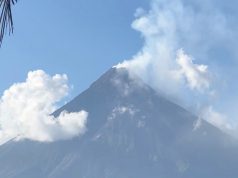

(UPDATE 3 – 2:12 p.m. Saturday, January 27) LEGAZPI CITY, Philippines – The Philippine Institute of Volcanology and Seismology warned of potential lahar and sediment-laden flows in river channels draining the slopes of Mayon Volcano as heavy rains drenched Albay Saturday, January 27.
Phivolcs urged local governments along river channels leading from Mayon to be “additionally vigilant and to move residents to high ground when heavy rains occur.”
PHIVOLCS ADVISORY WARNING OF POSSIBLE LAHAR FLOWS:

The National Disaster Risk Reduction and Management Council said it was bracing for a possible three-month-long emergency in areas around Mayon, which has already displaced close to 90,000 persons and led to overcrowded temporary shelters.
But on Friday, the Civil Aviation Authority of the Philippines announced the resumption of commercial operations at Legazpi Airport, starting 3-5 p.m. of that day and from 6 a.m. to 5 p.m. daily from Saturday, January 27, until January 31.
Earlier, the NDRRMC said Mayon’s activity had led to the cancellation of 97 flights.
An advisory issued by Phivolcs late Saturday morning, said Mayon’s restiveness has deposited some 9 million cubic meters of pyroclastic density current material on the volcano’s slopes, “excluding unverified deposits on the northern flank.”
It also estimated ashfall volume on Mayon’s western sector at 1.5 million cubic meters.
“These deposits can be remobilized by rainwater and generate lahars by themselves and/or by incorporating existing erodible material on channel banks,” Phivolcs warned.
The river channels to watch, it said, are Buyuan, Miisi, Mabinit, Basud, San Vicente, Buang, Quirangay and Masarawag-Maninila.
Phivolcs chief Renato Solidum said instead of lava fountaining overnight, there had only been a steady lava flow even as he stressed they are no discounting the possibility of a hazardous eruption.
Mayon remains at Alert Level 4, meaning a hazardous eruption is imminent, as it continued to spew lava, ash and other superheated material, volcanologists said.
“We’re gearing up for three months” of emergency, said Romina Marasigan, NDRRMC spokesperson, citing similar situations during previous eruptions of the 2,462-meter (8,077-foot) volcano.

Displaced families may need to stay in evacuation centers for that long, she said.
Food and other supplies remain adequate but concerns are growing over health and hygiene conditions at all the 69 temporary shelters away from the danger zone.
Respiratory illnesses are possible because of the series of ash falls, she said.
“We remain on red alert,” Marasigan told a media briefing, adding that 69,672 evacuees were housed in schools while nearly 12,000 took shelter in tents or went to relatives in more secure locations.

Health workers are giving free check-ups and medicine to elderly women and children in evacuation centers grappling with a sanitation shortage.
“The province is doing everything to close the gaps for these toilet facilities,” said Health Assistant Secretary Nestor Santiago.
Telecoms firm PLDT-Smart said its broadband and wireless networks around Mayon have remained operational, and that it had set free Libreng Tawag, charging and wi-fi stations in selected evacuation centers:
- GUINOBATAN – Guinobatan East Elementary School
- LEGAZPI – Bagumbayan Central School
- STO. DOMINGO – San Isidro Elementary School
- MALILIPOT – San Jose Elementary School
- DARAGA – Upper Malabog Elementary School and Albay Central School
The Philippine Institute of Volcanology and Seismology recorded three incidents of “sporadic lava fountaining” of from 24 to 40 minutes’ duration on Mayon’s summit that generated ash plumes of as high as 3 kilometers above the crater and fed lava flows in the Mi-isi and Bonga Gullies on Friday afternoon.
It also recorded one pyroclastic density current in the Mi-isi Gully.
Phivolcs said there were 10 volcanic earthquakes, 21 tremor events, three of which corresponded to the lava fountaining events, and 21 rockfall events Friday.
Despite warnings to head for safety, some residents have refused to abandon their homes within the extended 8-kilometers danger zone, with farmers worrying about leaving crops and cattle unattended, while others split their time between homes and evacuation centers they say are crowded and uncomfortable.

Mayla Miraflor had a vehicle loaded and ready to flee if Mayon rages unchecked.
“We have this jeep when we need to run,” said Miraflor, who has eight children. “This is what we’ll use when the time comes. We will leave as soon as possible.” (with a report from Mon Gualvez, News5)










